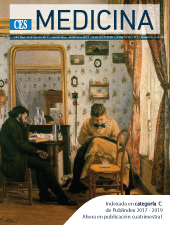Natural infection of Aedes aegypti, Ae. albopictus and Culex spp. with Zika virus in Medellin, Colombia
DOI:
https://doi.org/10.21615/cesmedicina.33.3.2Resumen
Introduction: The Zika virus has generated serious epidemics in the different countries where it has been reported and Colombia has not been the exception. Although in these epidemics Aedes aegypti traditionally has been the primary vector, other species could also be involved in the transmission.
Methods: Mosquitoes were captured with entomological aspirators on a monthly basis between March and September of 2017, in four houses around each of the 250 entomological surveillance traps installed by the Secretaria de Salud de Medellin (Colombia). Additionally, 70 Educational Institutions and 30 Health Centers were visited each month.
Results: 2 504 mosquitoes were captured and grouped into 1045 pools to be analyzed by RT-PCR for the detection of Zika virus. Twenty-six pools of Aedes aegypti, two pools of Ae. albopictus and one for Culex quinquefasciatus were positive for Zika virus.
Conclusion: The presence of this virus in the three species and the abundance of these species in the different sectors of the city, suggests that the control strategies should be addressed to all species that could be potential vectors until the vectorial role of Ae. albopictus and Culex quinquefasciatus is completely elucidated in the transmission of the Zika virus.
Descargas
Referencias bibliográficas
REFERENCIAS BIBLIOGRÁFICAS.
RIVAS DE ARMAS R. Canto Pérez M. artículo de rev. “Anomalías de número, forma y tamaño de los dientes. Consultado el 25/06/2014 disponible en: www.actamedica.sld.cu/rl_14indices.html. (2007), Vol. 1, No. 2 pp.1 y 2
ROCHA L. Frecuencia y variabilidad de la morfología dental en niños afro-colombianos de una institución educativa de Puerto Tejada, Cauca, Colombia. 2007 Consultado el 25/06/2014. Disponible en: www.redalyc.org/articulo
SAPIENZA, Gurrola Martínez. Consultado el 29 de junio de 2014. Disponible en:
http://www.ortodoncia.ws/publicaciones/2013/art8.asp
URIBE RESTREPO G.A. Ortodoncia Teoría y Clínica. Ed. Corporación Para investigaciones biológica; Medellín. Colombia: 2004.p. 165
KOCH G, Poulsen Sven. Odontopediatria Abordaje Clínico. Amolca. 2011
CAMERÓN A. Windmer R. Manual de Odontología pediátrica. Elsevier Mosby. Libro; 2010
SIMÓN-PARDELL M, Corrección de rotaciones con arco recto. 2003. Consultado el 25/06/2014. Disponible en www.revistadeortodoncia.com/files/2003.
QUIRÓS Álvarez O. Bases Biomecánicas y Aplicaciones clínicas en Ortodoncia interceptiva. 1ra Ed. Amolca. 2006. pp.69
GURKEERRAT Singh, Ortodoncia Diagnóstico y tratamiento, ed. AMOLCA, primera edición, Caracas Venezuela. 2012.: 480
CERVERA- Sabater A. Simón-pardell Corrección de rotaciones con arco recto 249. Rev. Esp.Ortod 2003;33:249-59
GRABER, Varnarsdall. Ortodoncia Principios y técnicas actuales. Editorial. Elsevier. Mosby. Libro 2006. Vol.16.No.1 y 2.
SORA B., Jaramillo V. RFOUA
Revista Facultad de Odontología Universidad de Antioquia. 2005.
SAMIR E. Bishara. Ortodoncia, editorial The Mc Graw Hill, México, junio del 2003:13.
CONTRERAS M. Somoza F et al. Dientes supernumerarios. Presentación de dos casos clínicos. Rev. Oper. Dent. Endod. 2007 Consultado 4/07/2014 disponible en: www.infomed.es/rode/index.php?option=com_content&id.
Quirós Alvares O. Ortopedia Funcional de los Maxilares y Ortodoncia Interceptiva. Ed. Amolca. 2010:11
Descargas
Publicado
Cómo citar
Número
Sección
Licencia
Derechos de autor 2019 CES Medicina

Esta obra está bajo una licencia internacional Creative Commons Atribución-NoComercial-CompartirIgual 4.0.
Derechos de reproducción (copyright)
Cada manuscrito se acompañará de una declaración en la que se especifique que los materiales son inéditos, que no han sido publicados anteriormente en formato impreso o electrónico y que no se presentarán a ningún otro medio antes de conocer la decisión de la revista. En todo caso, cualquier publicación anterior, sea en forma impresa o electrónica, deberá darse a conocer a la redacción por escrito.
Plagios, duplicaciones totales o parciales, traduccones del original a otro idioma son de responsabilidad exclusiva de los autores el envío.
Los autores adjuntarán una declaración firmada indicando que, si el manuscrito se acepta para su publicación, los derechos de reproducción son propiedad exclusiva de la Revista CES Medicina.
Se solicita a los autores que proporcionen la información completa acerca de cualquier beca o subvención recibida de una entidad comercial u otro grupo con intereses privados, u otro organismo, para costear parcial o totalmente el trabajo en que se basa el artículo.
Los autores tienen la responsabilidad de obtener los permisos necesarios para reproducir cualquier material protegido por derechos de reproducción. El manuscrito se acompañará de la carta original que otorgue ese permiso y en ella debe especificarse con exactitud el número del cuadro o figura o el texto exacto que se citará y cómo se usará, así como la referencia bibliográfica completa.
| Estadísticas de artículo | |
|---|---|
| Vistas de resúmenes | |
| Vistas de PDF | |
| Descargas de PDF | |
| Vistas de HTML | |
| Otras vistas | |



